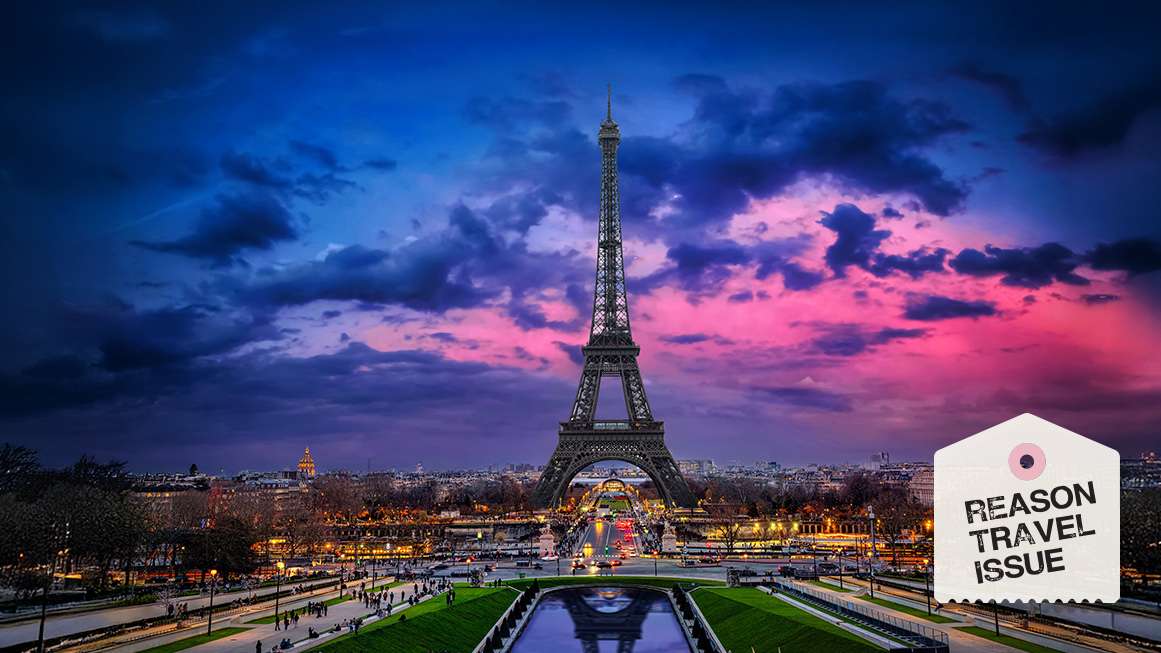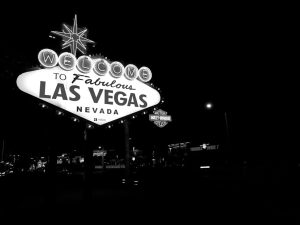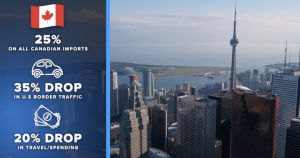Travel
|
This is part of Reason‘s 2025 summer travel issue. Click here to read the rest of the issue.
If you ever go to New Orleans, one of your first stops should be the very unhidden gem of Café Du Monde’s French Market location. There you can buy some New Orleans special beignets and, if the weather is hot enough (it almost certainly will be) a frozen coffee to wash them down.
Café Du Monde is popular. The advice to go is often not popular.
If you scan internet messaging boards about what to do in New Orleans, posters will often caution against a visit to Café Du Monde. It is dismissed as the most hated of all destinations, a “tourist trap”: an overrated, overcrowded cliché that exists to suck money from unsophisticated travelers in exchange for an unsatisfyingly ordinary experience.
Yet this aversion to Café Du Monde is obviously mistaken to anyone who does actually go there. The lines are long, yes, but they move fast. The beignets might not be literally the best in the world, or even in New Orleans. But they’re good! Better yet, they’re available at a reasonable price. And once you’re done with your fried treat, you can walk to any number of other serviceable tourist destinations nearby.
Raging against this delightfully efficient travel experience is a particular strand of travel ideology that encourages you to avoid the “tourist track” in favor of more authentic, higher-quality experiences to be found off the beaten path. Travel content creators, whether on social media or the Food Network, traffic in glamorizing the latter travel experience. Not much travel media could persist without it. There’s only so much content one could watch about other people going to see the Louvre or the Vatican or Times Square, after all.
Certainly, when one is traveling vicariously from the couch, it’s fine to revel in hunts for the next world-famous hole-in-the-wall. When we’re transporting ourselves in reality, the real rewards will often be found among the greatest hits.
There’s a reason for this, and it comes down to two concepts: economies of scale and agglomeration.
Economies of scale is the idea that firms can lower their average costs by producing more units. In other words, if you set up your operation to make a lot of widgets, the cost of making each widget is a lot lower than what could be made by a small widget-making operation.
This is effectively what the largest landmarks and tourist traps do. The National Mall and the Eiffel Tower were built to receive millions of people. Therefore, they’re easily able to provide you, the marginal tourist, a satisfying experience at an ever-falling cost. Your presence adds a tiny additional cost to operating bathrooms, maintaining walking trails and directional signage, and even paying staff to tell people where they need to go and where not to spit their gum. The marginal expense of providing you the opportunity of a forced–perspective photo where you hold the Washington Monument aloft is effectively zero.
This is hardly the case with more niche destinations.
The obscure hiking trail with the perfectly instagrammable view likely suffers from increasing diseconomies of scale. These places work when they’re patronized by locals and a few regional tourists. Once they go viral, they’re quickly swamped. Parking lots are over capacity, trash overflows, and the marginal visitor’s photo opportunity imposes severe costs on everyone else. It’s why these destinations top internet lists of sights being “ruined” by tourists, even if their root purpose is to be a visitable sight to see.
Gastronomical destinations operate under a similar logic. To return to Café Du Monde: This is a place that takes every advantage from economies of scale. Its food menu is very simple, with just one item: beignets. Its drink menu is a delightfully uncomplicated offering of coffee in its three natural states of hot, iced, and frozen. As a slight extravagance, they’ve added hot chocolate and bottled water to the menu. Café Du Monde can thus focus on pumping out a few dedicated specialties quickly and at a reasonable cost to both producer and consumer. These production savings can be poured into more staff, bringing faster service.
In contrast, a heretofore undiscovered café, restaurant, or bar typically isn’t prepared to handle even a modest surge in visitors. Newfound publicity quickly takes them overcapacity. Small-time businesses have no good options for digging their way out of a rush of tourists looking for the next big thing.
In an effort to maintain their authenticity, they might try to keep everything—from location to the menu to the prices—the same as before. The result, then, is that you’ll likely wait around in a huge line for hours. Perhaps, like good capitalists, they’ll raise prices to manage higher demand. That’s good for the business, of course: No one should begrudge them for seizing an enhanced opportunity for profit. But the higher price, like the longer wait, will take a huge bite out of whatever utility you might get from a slightly higher quality specialty dish from a more authentic local hole in the wall.
For all that effort to see something off the beaten path, the tourist’s consumer surplus is just as likely to go down as up. Meanwhile, the more popular the tourist trap, the greater the benefits to tourists will be.
For travelers, there’s an instinct to skip anything that seems too generic in favor of something more special and memorable. The fear of crowds and long waits overwhelms the desire to see something truly unique. Why go see the Mona Lisa in Paris, when everyone who visits Paris goes there and everyone visiting Paris at the same time as you will also be there? It’s an understandable attitude, but a mistaken one. It fails to appreciate the urban agglomeration that creates the world-class tourist cities that give people a reason to travel in the first place.
Urban agglomeration is basically the idea that people want to be where the action is. Workers move to cities because that’s where the jobs are. Firms move to cities because that’s where the workers are. As more and more people pile into an area, the whole becomes greater than the sum of its parts. Interpersonal networks become thicker, and the division of labor becomes more specialized.
This agglomeration logic continues to apply, even as the costs and externalities of city life pile up. With more people come more traffic and more pollution. But the benefits of more people doing more and more things together always seems to outweigh the associated costs. Keep this agglomerative growth going, and eventually your city will be large enough, and the division of labor specialized enough, to create and sustain the unique cultural amenities that people travel across the globe to see.
There’s only so many great artists and great pieces of art in the world. Urbanism’s agglomerative pull means many of them end up in a handful of superstar cities. Millions of tourists then follow. The Mona Lisa wasn’t painted in Paris. She lives there nonetheless because that’s where the eyeballs and the money are. Paris, in other words, exists for you to go see the Mona Lisa. To say that you won’t go see the Mona Lisa because that’s what everyone does in Paris is to miss the point of Paris.
It’s a point even the Parisians can miss. Carlos Moreno—the Sorbonne University professor most famous for creating the idea of the “15-minute city”—has argued that Paris could improve walkability and reduce traffic congestion by using neighborhood schools as playhouses and theaters after hours. On the other hand, “How many Parisians prefer to attend a concert, a ballet, or an opera at a neighborhood school rather than the Garnier Opera House, Opera Bastille, or the Bataclan?” counters the French urbanist Alain Bertaud. “Do these prestigious establishments have to be replaced with neighborhood shows that will give the spectator the satisfaction of walking there and saving about twenty minutes on transport?”
To be sure, not every “tourist trap” is worth the visit or worth the expense. A shirt proclaiming how much you love New York can be bought online. You should also always be on the lookout for scams. And not every minute of a vacation needs to be dominated by sightseeing. If relaxation is the goal, there’s a lot to be said for finding a café, bar, or restaurant within walking distance from the hotel and making that your home base for the trip.
But if you are trying to see and do things, you should see and do the things that are ready for you. Don’t burn up your vacation days sacrificing efficiency in a fruitless quest for authenticity. The tourist traps were made for tourists. They know what they’re doing. If you’re a tourist, there’s no shame in enjoying them.
This article originally appeared in print under the headline "In Defense of ‘Tourist Traps’."
Rent Free is a weekly newsletter from Christian Britschgi on urbanism and the fight for less regulation, more housing, more property rights, and more freedom in America’s cities.
Cincinnati’s Beer-Loving Germans Endured Anti-Immigrant and Anti-Alcohol Resistance
is a reporter at Reason.
Show Comments (40)
|
|
|
|
|
© 2024 Reason Foundation | Accessibility | Privacy Policy | Terms Of Use
This site is protected by reCAPTCHA and the Google Privacy Policy and Terms of Service apply.
Do you care about free minds and free markets? Sign up to get the biggest stories from Reason in your inbox every afternoon.
This modal will close in 10
Just $25 per year




